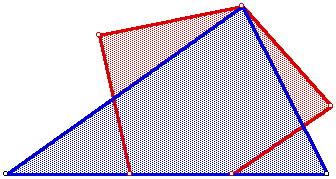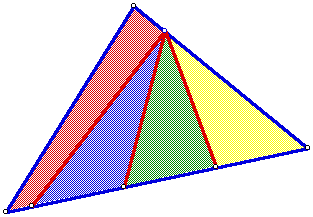



For a GSP script that performs the procedure for a pentagon
or a hexagon click on the appropriate
word.
Project 3:
Given a triangle ABC, with a point P on one of the sides, show how you can
divide triangle ABC into any number of equal parts (begin with 4) using
lines drawn through P. (NOTE: an explanation of how/why
the procedure works is expected) You will notice
that there are limits on the position of point P if you wish to ensure an
interior division of triangle ABC.

For a GSP script that performs the procedure for four
equal parts click here.
Project 4:
Given a square ABCD, show how you can divide the square into any number
of equal parts (begin with 5) using lines drawn through one of its corners.
(NOTE: an explanation of how/why the procedure works
is expected)

For a GSP script that performs the procedure for five
equal parts click here.
Project 5:
Given a rectangle, show how you can divide it into any number of equal parts
(begin with 3) using lines drawn through a point on one of its sides. (NOTE:
an explanation of how/why the procedure works is expected)

For a GSP script that performs the procedure for three
equal parts click here. You will notice that
there are limits on the position of point P if you wish to ensure an interior
division of rectangle ABCD.

For a GSP script that performs the procedure for five
equal parts click here.
Project 7:
Given a square ABCD, show how you can divide the square into any number
of equal parts (begin with 5) using lines drawn parallel to one of the diagonals
(HINT this project follows very closely from the previous
project and project 4). (NOTE: an explanation
of how/why the procedure works is expected)

For a GSP script that performs the procedure for five equal parts click here